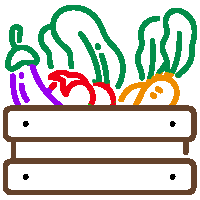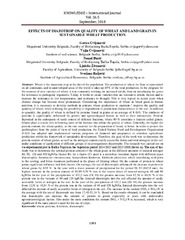Приказ основних података о документу
Effects of diazotrop on quality of wheat and land grain in sustainable wheat production
| dc.creator | Cvijanović, Gorica | |
| dc.creator | Cvijanović, Vojin | |
| dc.creator | Đurić, Nenad | |
| dc.creator | Živanović, Ljubiša | |
| dc.creator | Roljević Nikolić, Svetlana | |
| dc.date.accessioned | 2021-08-13T10:17:22Z | |
| dc.date.available | 2021-08-13T10:17:22Z | |
| dc.date.issued | 2018 | |
| dc.identifier.issn | 1857-923X | |
| dc.identifier.issn | 2545-4439 | |
| dc.identifier.uri | http://RIVeC.institut-palanka.rs/handle/123456789/343 | |
| dc.description.abstract | Wheat is the important crop in the diet of the population. The production of wheat for flour is represented on all continents, and in undeveloped areas of the world it takes up 85% of the total production. In the program for the creation of new varieties of wheat, it was constantly working on increased yields, then on introducing the genes for resistance to pathogenic organisms. Today, it works to create varieties that are tolerant to abiotic factors and to increase the resistance to low temperatures, and resistance to drought. This is very topical in recent years when climate change has become more pronounced. Considering the importance of wheat as bread grain in human nutrition, it is necessary to develop methods in primary wheat production to maintain / improve the quality and quantity of wheat, while reducing the possibility of degradation of production characteristics of the soil. In addition to quantity, the quality of wheat is defined by proteins found in grains at an average of 8-16%. The synthesis of proteins is significantly influenced by genetic and agroecological factors as well as their interactions. Proteins deposited in the endosperm of seeds consist of different fractions, where 80 % constitute a fraction called gluten. Gluten plays a crucial role in forming most of the features that define the quality of wheat. Generally, the higher the protein content, the wheat quality, as the raw material for the preparation of bread, is better. In order to protect the geobiosphere from the point of view of food production, the United Nations Food and Development Organization (FAO) has adopted and implemented various programs of financial and pragmatics to stimulate agricultural production within the framework of sustainable development. Therefore, the goal of the work was to determine the protein content of wheat grains, as well as the nitrogen content (easily accessible forms and total nitrogen) in the soil under conditions of application of different groups of microorganisms-diazotrophs. The research was carried out on the experimental plot in Bačka Topola in the vegetation period 2014/2015 and 2015/2016 (factor A). The aim of this study was to determine the optimal protein content of the wheat grain in the different amounts of mineral nitrogen 60, 90, 120 and 150 kgN/ha (factor B). As a factor (C) used is a microbial inoculum liquid with different types diazotrophes Azotobacter chroococcum, Azospirillum lipoferum, Klebsiela planticola which inoculating seed prior to the sowing, and foliar treatment performed in the phase of tillering wheat. On the content of protein in wheat grains significant influence had both factors. On average, the use of diazotrophs influenced the increase in protein in wheat grains by 6.93 %. In the year with a lower amount of precipitation for the period IX-VI (162,8 mm), the highest increase in the protein content of 10,89-9,70 % was at the lowest doses of mineral nitrogen, 60 and 90 kgN/ha. In the year of the precipitation of 432,2 mm (IX-VI) the greatest increase from 12,31 to 10,34 % of the protein was in the variants of 60 and 120 kgN/ha. Entered diazotrophs into the soil affected the amount of easily accessible forms of nitrogen in the soil. In the year of the precipitation of 432,2 mm (IX-VI) the greatest increase from 12,31 to 10,34 % of the protein was in the variants of 60 and 120 kgN/ha. Entered diazotrophs into the soil affected the amount of easily accessible forms of nitrogen in the soil. The increase in the content (NO3 + NH4)-N in the average with the use of diazotroph was from 17,40-33,16 %. Based on the results obtained, it can be concluded that diazotrophs can increase the amount of protein in grains especially in years with unfavorable agrometeorological factors. Also under the same conditions the content (NO3 + NH4)-N is increased, which is very significant if the same parcel is used for the use of crops. | sr |
| dc.language.iso | en | sr |
| dc.publisher | Bansko : Institute of Knowledge Menagement, Bulgaria | sr |
| dc.relation | info:eu-repo/grantAgreement/MESTD/Integrated and Interdisciplinary Research (IIR or III)/46006/RS// | sr |
| dc.relation | info:eu-repo/grantAgreement/MESTD/Technological Development (TD or TR)/31092/RS// | sr |
| dc.rights | openAccess | sr |
| dc.rights.uri | https://creativecommons.org/licenses/by-nc-nd/4.0/ | |
| dc.source | KNOWLEDGE – International Journal | sr |
| dc.subject | wheat | sr |
| dc.subject | proteins | sr |
| dc.subject | fertilizers | sr |
| dc.subject | diazotrophs | sr |
| dc.title | Effects of diazotrop on quality of wheat and land grain in sustainable wheat production | sr |
| dc.type | article | sr |
| dc.rights.license | BY-NC-ND | sr |
| dc.citation.epage | 1400 | |
| dc.citation.issue | 5 | |
| dc.citation.spage | 1393 | |
| dc.citation.volume | 26 | |
| dc.identifier.fulltext | http://RIVeC.institut-palanka.rs/bitstream/id/821/bitstream_821.pdf | |
| dc.identifier.rcub | https://hdl.handle.net/21.15107/rcub_rivec_343 | |
| dc.type.version | publishedVersion | sr |


